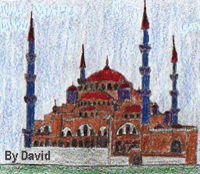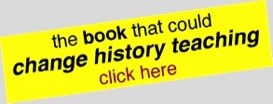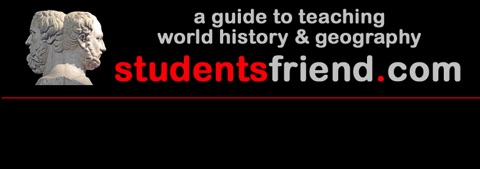View online or download the Student's Friend
What teachers say about the Student's Friend
Combining world history and geography
Why use the Student's Friend?
The Student's Friend contains enough information.
Although I wrote the Student's Friend and taught from it for a number of years, even I couldn't remember every historical detail it covers. You and I both know that most of the facts students learn in history courses will be lost from memory in a relatively short period of time—perhaps as soon as the next exam is over.
We also know that its It's preferable to learn a concise amount of important knowledge well (so that it can be recalled later) rather learning a lot of trivial information poorly. "Quality over quantity,"as they say. Students are more likely to retain knowledge in memory when it's part of a coherent and understandable overview of history rather than when it's comprised of an incomprehensible jumble of disconnected elements.
The respected Bradley Commission on History in the Schools recommended that the following question be asked when designing the structure and content of history courses:
"Has the notion that "less is more" been considered as themes, topics and questions are selected? The amount of time required to achieve student engagement and genuine comprehension of significant issues will necessitate leaving out much that is "covered" by the usual text."*
It leaves time for in-depth learning activities.
A concise narrative gives teachers an opportunity to strike a reasonable balance between breadth and depth. Use of a concise historical narrative leaves time in the curriculum to engage students in in-depth learning activities such as research projects, source analysis, and simulations that are meant to cement student understanding of important historical and geographic concepts.
It reduces gaps and discontinuities
History teachers can't hope to adequately cover all the material in thousand-page textbooks, so they must pick and choose—trying to identify the most important information to present to their students. This places an unnecessary burden on teachers—especially new teachers—who may not be intimately familiar with the extensive subject matter of world history and geography. Picking and choosing means that students must skip around in their textbooks, which leads to gaps and discontinuities.
By contrast, the Student's Friend was designed to include no more information than students can realistically cover during a standard high school course. Within this constraint, the Student's Friend identifies a coherent body of knowledge representing a meaningful overview of world history including Western civilization and important geographic concepts. Because the picking and choosing has already been carefully done and logically sequenced, continuity is maintained and gaps are eliminated.
Integrates world history and geography
World history and geography are inseparable; they represent the time and space dimensions of human experience. The Student's Friend integrates world history and geography throughout. Each unit designates locations to be identified in relation historical developments that occurred there.
Themes of geography are encountered within meaningful historical contexts rather than as abstract concepts. For example, the concept of "movement" is encountered as Homo Erectus moves out of Africa, Hebrews are exiled to Babylon, Vikings settle in Russia, and Europeans migrate to America.
Organized to be mind friendly
The Student's Friend is organized to aid learning and memory. Cognitive research indicates that the mind organizes new information into meaningful "chunks" of related information, while long-term memories are stored under mental categories similar to the file folders in a file cabinet.
Each page of the Student's Friend is organized into four sections, and each section is labeled with a topic heading that represents a related set of facts and ideas. Thus, the information in the Student's Friend has been organized into meaningful chunks, making it easier for knowledge to enter long-term memory and become available to inform student thinking in the future.
Clearer understandings
Perhaps the greatest value of the Student's Friend lies with the clarity it can bring to a student's understanding of history by focusing on essential knowledge rather than on extensive, confusing, and often trivial detail. Educational psychologist Frank N. Dempster has written that U.S. textbooks are
"unrivaled in size and amount of information covered....Unfortunately, many texts are so packed with facts, names, and details that the real point of the lesson is often obscured."**
A classroom example may serve to illustrate the professor's point. I gave my tenth-grade students a standard textbook assignment that consisted of reading a section on the Congress of Vienna and answering the questions at the end of the section. When the students were finished, I asked what they had learned. They responded by listing the various diplomats who attended the Congress and by identifying several specific changes to international boundaries that resulted from the meeting. These responses were to be expected since the bulk of the reading was given over to this type of factual detail that few students would remember by dinnertime.
My students entirely missed the big picture that the Congress of Vienna was an attempt to undo the egalitarian changes brought about by the French Revolution and Napoleon and to return Europe to the old aristocratic order. Students also missed the more general concept that the Congress of Vienna represented a clash between the perennial political poles of conservatism and liberalism.
While these were the most important concepts in the section, and they were relevant to the lives of my students, they were completely lost amid the kind of mind-numbing textbook detail that generates perceptual static and interferes with meaningful understanding.
The textbook used five pages to obscure the important meanings of the Congress of Vienna, whereas the Student's Friend uses two paragraphs to identify the major concepts involved and, moreover, to relate conservatism and liberalism—the political right and the political left—to the major political parties operating in the United States today.
How to use the Student's Friend
The Student's Friend is available for free download in pdf and MS Word formats. It can be printed and distributed to students for classroom use, or it may be used online as an electronic or digital textbook.
Student's Friend Part 1 (prehistory to 1500) and Part 2 (1500 to the present) were designed to be taught in a two-year sequence, but many teachers may find they are limited to teaching only one of these two historical periods. If a teacher is forced to combine all of human history into a single course, my sincere condolences...but the Student's Friend may be downloaded in Microsoft Word format and modified by the teacher to reduce the number of topics covered.
Each part of the Student's Friend is 24 pages long (26 with optional cover pages), but because it is printed on 8-1/2" x 11" paper with no illustrations and minimal white space, its 48 pages are equivalent to approximately 150 pages in a standard textbook. When each student is provided with his or her own copy, the packet for one course totals 12 or 13 sheets of paper when printed on both sides.
A teacher using the Student's Friend will want to supplement the text with visual images. For years, I used an overhead transparency projector to project historical images on a screen at the front of the classroom until my school supplied me with a digital projector that could display still images as well as videos.
The Teacher Tools section of this website provides various instructional activities that may be used in conjunction with the Student's Friend.
-Mike Maxwell, updated March 27, 2016
_________
*Bradley Commission on History in Schools, Building a History Curriculum: Guidelines for Teaching History in Schools," National Council for History Education, 2000
**Dempster, Frank N.,"Exposing our students to less should help them learn more," Phi Delta Kappan, February , 1993
© 2001-2016 Michael G. Maxwell, Maxwell Learning LLC
_______
The following advertising supports studentsfriend.com:
Using the Student's Friend:
Why and How?
The Student's Friend is a concise narrative of world history that provides students with

an understandable overview of human development through time.
Also see:

